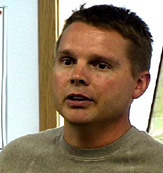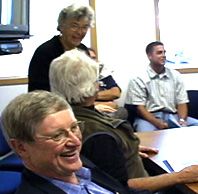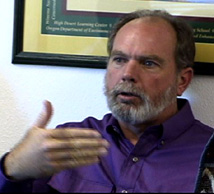KBC Home
Tour Table
of Contents
o Bus tour overview by Dan Keppen, Executive Director of Klamath Water Users Association
| Keppen:
Can I just provide a quick overview of the
tour, of what we will do? Unfortunately Iíve got to leave out of town here
in just a little bit.
I am Dan Keppen. I am the Executive Director
of Klamath Water Users Association. I wonít be able to directly
participate in this tour, but we helped line some people up to guide you
through. Iíve got some handouts here too that Iíll just start handing out
as Iím speaking. This will only take a couple of minutes.
|
 |
I wanted to give you an overview of where you're going to go today, and a lot of the things that you are going to see later will tie into what you've heard earlier. Could I have a show of hands for the folks from Humboldt? Okay, Iíve got a different perspective of things that happened last fall, which I have here for you to take a look at. This is an assessment completed by our biologist of the fish die-off last fall.
The association that I represent represents the irrigation districts, ditch companies, water districts within the Klamath Project. There are 17 of them. It represents roughly 200,000 acres. My board of directors has representatives who are essentially elected officials; they are board members on their own individual irrigated districts, and are elected by their patrons. The association has been around since 1953. We were actually created to try to provide some political influence at that time on the power negotiations that were going on with CopCo.
From here, today, you will go to the headgates of the Project and then you will follow the A Canal downstream through the Project, make a couple stops, and you will meet some folks lined up to talk to you on the way. First stop will be at the headgates. I think Christineís crew will talk about that. Thatís a project we're all proud of, we're proud of what Reclamation has done, what local irrigation districts have done, to try to push the thing forward over the past 10 years. I mean, they built this thing in about 7 months. It is a $15 million structure. Itís intended to protect the endangered suckers in the lake.
From there weíll head through town and out to Olene, where there is a gap there where the Lost River comes out from the Poe Valley, the east side of the Project. You won't have time today to go out Gerber and Clear Lake on the east side or Poe Valley, or Langell Valley, but weíll meet Bruce McCoy in Olene. Heís the manager of the Horsefly Irrigation District and weíll get out, and see the Lost River in all itís pristine beauty today. The Lost River really is no longer a river. Once they drained Tule Lake it became basically a delivery system, but itís an important part of the Project. Bruce will talk about whatís out on the east side for about 20 minutes so you can get out and stretch.
From the headgates out to Olene, Ken Rykbost will provide an overview of the hydrology of the basin. Heís just finished some findings that heís put together on watershed hydrology. Itís really eye-opening, and Ken did a great job the other night for the county commission, gave a 45 minute power point laying out his findings. Too bad he is not going to have the graphics with him, but itís a pretty interesting assessment and I think it gets to the truth of some of the hydrology reality of the Klamath watershed. I think you'll be given a different perspective on hydrology. There are some things portrayed in the media that just arenít right. And Kenís presentation will hopefully give you some straight information on this topic.
From Olene, weíll follow the north part of Stukel Mountain along Hill Road. Lost River diversion dam - also called the Horseshoe Dam - youíll see it. Itís an important facility. It allows water to be moved from the Lost River to the Klamath River through the Lost River diversion channel, which is essentially flat; water can go both ways.
From there weíll head south and basically follow the water downstream along Hill Road. This area is pretty important because in 2001, when there was a lot of ground water pumping going on and the canals were dry, some shallow wells dried up in that area. And we found since then, in the last two years, that thereís been some heavy ground water pumping, but we havenít seen those sort of impacts. Itís probably because there is water in the delivery system and that provides a recharge source for the shallow domestic wells. Harold Hartman who is one of my board members from the Malin area, will talk about that. Heíll point out some lands in this area that are in the idling component of the current water bank. Youíll see what idled land looks like; itís not pretty. There are also some areas out there that are pumping ground water in place of surface water this year, through the environmental water bank, where they are getting compensated. Also, we estimate roughly 50,000 acres feet of ground water is being pumped right now at land owner's expense with no compensation to help meet the lake level requirements for suckers. We're looking for ways to try to get some of those farmers compensated this year.
Harold will pretty much guide the tour all the way through Malin. Malin's an old Czech community and thereís some great history there. Along the way we'll talk a little bit about the impacts of 2001 and how that affected the communities and how we're still reeling from those impacts. That cut off had very real impacts despite efforts here in the last year with certain environmental groups trying to downplay what happened. Itís very serious and youíll have a chance today to talk to some people on the bus that went through quite an experience and who are still feeling the effects.
From Malin weíll head south towards Tulelake Irrigation District and Tule Lake. John Crawford, who is a board member with TID, is going to be on the tour. Deb Crisp with Tulelake Growers Association is also on board, as well as Harry Carlson from U C Extension. Weíre going to see things like a canal lining project that TID's put in over the last year to conserve water. They are going to show you some things on the refuge, the flood/fallowing that was mentioned earlier. Thereís a ton of birds out there right now, and Johnís going to take you in, and you can see the incredible bird numbers. Itís a great time to check that out. Youíll also see the infamous TID wells the state of California funded and helped install in 2001. I think, Bill, those wells are probably some of the most productive wells in the State in California as far as I know.
Bill: Most affective huh?
Keppen: Yes, they are effective, no doubt. Those wells have provided a lot of substitute water when Project water was unavailable.
Weíre going to stop by the D Plant, which pumps water from the Tule Lake side through Sheepy Ridge over to the Lower Klamath, work our way back up along stateline, and head over to Highway 97. Fran has just agreed spontaneously to tour that portion; he will give us a tour of the refuge there. As we head up 97, Dr. Rykbost will talk about some of the things that were laid out earlier: the historic changes, what happened when the railroad was built, what it did to flows, what you have there now compared to what was there before the Project was built. The role of evapo-transpiration in both situations. Cecil kind of touched on that earlier. Youíll be able to see for yourself whatís happened.
And then John Crawford, that last leg of the trip as we're heading back Klamath Falls, is going to give some observations about whatís happen the last 10 years above the lake. Alice, youíre going to take them out there tomorrow and show everybody whatís happening with management above the lake. Itís a real big issue to water users because thereís been support for those types of projects above the lake in the last 10 years, but water users always felt that there was going to be some sort of water management flexibility provided in the lake levels in exchange for supporting those projects and itís never materialized. In fact, we had 2001 where the Project was shut down, in the beginning of the year, and that has really affected people's attitude towards supporting more projects of that sort. So John will talk a little bit about that as you guys prepare for your tour tomorrow.
So thatís really all I had. I wish I could be on the tour, but I think we have some good people lined up, and I am just happy to see that you took the time to come up and learn the issues. I think we still have some pretty divisive things that we need to hammered out because when this whole process was rolled out there was some negative reaction here in the local community just because it was perceived as folks downstream saying 'hey Ag is impacting the river'. It was done at the same time when a lot of other things were coming out, where the fish kill was being exploited by certain groups, and this event seemed like it was taking advantage of that, or being done in concert with that, by a lot of folks up here. I donít think that was the case from your standpoint. But that was the initial reaction up here.
I guess before I leave, I would just like to say we're all about trying to coordinate. Thatís a big part of the problem here in the basin; weíve got a lot of diverse interests and agencies and two states and a strong federal presence. Weíve got great experts up here with the UC Extension, the OSU Extension, and OIT, and water users, and local agencies. If things are going to be done, I think the the locals need to take the lead in developing the information and having a say in policy decisions. I donít think the folks down river would want Klamath Water Users saying, 'we're going to create an institute and control data that has to do with flows downriver and fish conditions'. Thatís just something to be aware of; itís very sensitive right now.
Again, I just appreciate the fact that you came up here and you're willing to see the Project and see for yourself whatís going on. I think itís a great opportunity.
 |
Richmond: And we appreciate your working in setting up a good tour for us,
with Christine and Alice. These are a lot of people who have devoted a couple of
days to these efforts so we appreciate the opportunity to learn.
Keppen: Well thanks, and yes these guys are doing the work. I am cutting out of here right now unfortunately.
Alice Kilham, organizer, in back, Richmond front. |
| Bill Bennet, California Department of Water Resources Klamath Coordinator: We went through a lot of stuff thatís going on here in the tour thatís really up here. We mentioned TMDL work in California, but thereís also a parallel process with the Coho Recovery Plan and not to bring it up here, but if you have any interest in that, I am involved with that in California, so corner me on the tour and Iíll talk to you about that. |  |
_____________________________________________
#8
o Impacts of the two
biological opinions for suckers and for salmon,
and how that has changed the parameters of Project
operations over the last 10 years, by John
Crawford, Project and leaseland farmer.
o
At the Fish Screen on A Canal